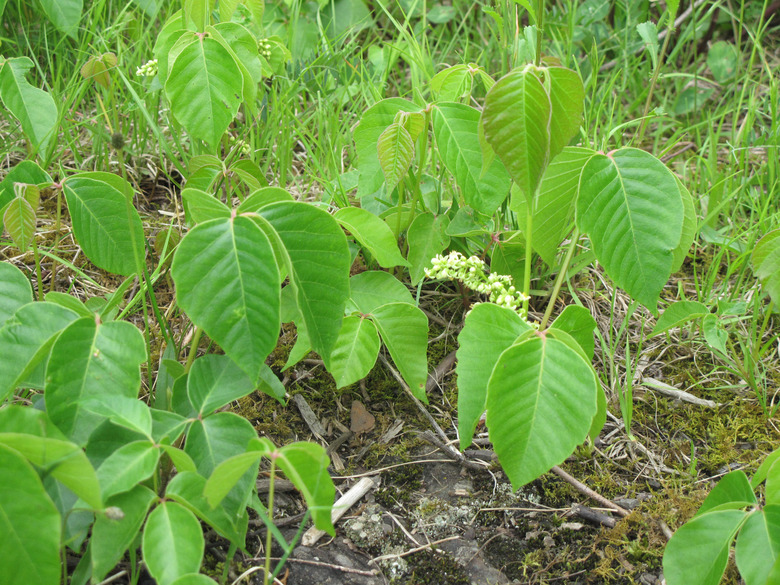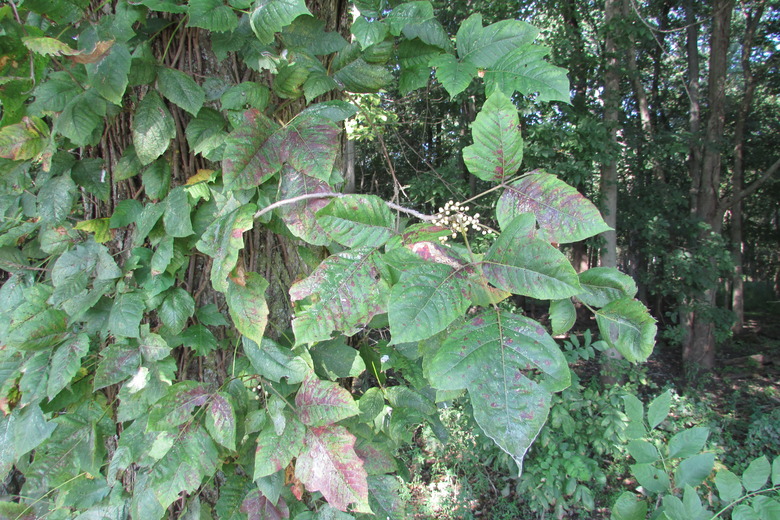Sprays That Will Kill Poison Ivy, But Not Grass
Poison ivy is the scourge of summers, invading all those enticing wooded paths and—sometimes—your own yard.
If poison ivy (Toxicodendron radicans, USDA hardiness zones 4 to 10) has crept into your lawn, you probably don't want to try removing it by hand, which could invite its itching blisters while not eradicating it. Your options are to mow it regularly or apply a selective herbicide that won't also kill your lawn.
About Poison Ivy
Poison ivy is native throughout the U.S. and southern Canada, where it is widespread in multiple wooded areas, along roadsides, and in valleys or clearings where it has invaded. It may appear as either a shrub or a poison ivy vine.
Poison ivy's compound leaves are characteristically in groups of three, and its leaves are shiny and bright green, turning red in the fall. A famous saying is "Leaflets three, let it be," according to North Carolina State Extension.
The root of poison ivy's poison is urushiol oil, which is present in all parts of the plant, as well as in poison sumac (Toxicodendron vernix) and poison oak (Toxicodendron diversilobum). It causes a tremendously itchy rash in most people. While you might brush against it yourself, a common way to come into contact with it is indirectly, such as from a pet, garden tool or shoes.
How to Get Rid of Poison Ivy
If the poison ivy is a recent, unwelcome addition to your lawn, you can try cultural controls, but if it is established, you will likely need to resort to chemicals.
However, use chemicals as a last resort because repeated mowing can control poison ivy over time.
Manually Removing Poison Ivy
Manual removal entails either digging out the poison ivy plants or mowing them.
You can remove poison ivy by hand if you wear protective clothing, including waterproof gloves, heavy long pants, and a shirt with long sleeves. Dig it out with a trowel or shovel, trying to get the entire plant and its root. It will regrow from any remaining roots.
Warning
After exposure to poison ivy, remove your clothing carefully and place it in a plastic bag. Dump it directly from the bag into the washer and wash it in the hottest water safe for the fabric. Avoid any direct contact with the clothing, and don't allow it to touch the outside of the washer. Discard the plastic bag and the waterproof gloves you used.
Alternatively, mow any new growth as soon as it appears. Then rake up the debris and throw it into the trash. Repeated mowing over years blocks the plant's ability to regrow and eventually kills it.
Using Herbicides to Kill Poison Ivy
Many herbicides, including the common and effective glyphosate (RoundUp), are non-selective and kill any plant they come in contact with, including grass lawns. To protect desirable plants from damage, use a selective herbicide or one developed to target a specific set of plants.
Warning
Avoid the use of herbicide mixtures containing 2,4-D as this chemical is only marginally effective against poison ivy, and it can injure numerous broadleaf plants.
The most recommended chemical for killing poison ivy plants is triclopyr, a selective herbicide that kills only broadleaf plants, not grass. Products containing this chemical are widely available in garden stores and nurseries. For example, Ortho's Brush-B-Gon Poison Ivy Killer or Bonide's Poison Ivy & Brush Killer both contain triclopyr and the chemical dicamba.
Warning
When using a herbicide—or any chemical—be sure to read all the label directions.
Apply herbicides when the poison ivy is fully leafed out. Wait for a warm, sunny day with no wind. Avoid spraying it on the bark of nearby trees, as some tree species can absorb it through their bark.

